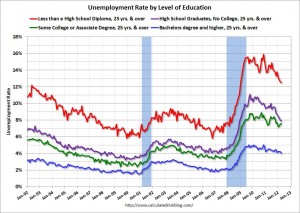07.05.2012
Policy Points
Calculated Risk graphs unemployment rates from 1992 onward by level of educational attainment. Rates are elevated for all groups, including those with at least a bachelor’s degree, and remain above the highs recorded at any time prior to the “Great Recession.”

04.05.2012
News Releases, Policy Points
CHAPEL HILL (May 4, 2012) – The national labor market cooled in April, as employers added just 115,000 more payroll positions than they eliminated. The unemployment rate, meanwhile, essentially held steady at 8.1 percent with unemployment rates among major demographic groups largely remaining unchanged. While the national labor market started 2012 on a positive note, growth has slowed over the course of the year.
“April marked the 19th consecutive month of job growth in the United States,” said John Quinterno, a principal with South by North Strategies, Ltd., a research firm specializing in economic and social policy. “Over the past four months, the economy has netted an average of 132,000 jobs per month, a pace that, while positive, is simply not enough to drive unemployment down to normal levels anytime soon.”
In April, the nation’s employers added 115,000 more payroll positions than they cut. Gains occurred entirely in the private sector (+130,000), while government payrolls fell by 15,000 positions due primarily to cuts by local governments. Additionally, the payroll employment numbers for February and March underwent revisions; with the updates, the economy gained 413,000 jobs over those two months, not the 360,000 positions previously reported.
Employment levels in most major private-sector industry groups grew or held essentially steady in April. Professional and business services netted the most positions (+62,000, with 52.1 percent of the growth occurring in the administrative and waste services subsector), followed by education and health services (+23,000, with the health care subsector responsible for 82.6 percent of the net gain), and trade, transportation, and utilities (+22,000, due overwhelmingly to gains in the retail trade subsector). Meanwhile, the construction, information, and other services sectors shed the most positions (all -2,000).
“The American economy has added jobs steadily for a little more than 1.5 years and has netted 528,000 positions so far in 2012,” noted Quinterno. “The current pace of job growth is nevertheless modest relative to the size of the overall jobs gap, and, alarmingly, growth has slowed over the course of the year. A return to normal labor market conditions remains a distant goal, absent more attention and support from policymakers.”
Weak employment conditions were evident in the April household survey. Last month, 12.5 million Americans (8.1 percent of the labor force) were jobless and seeking work. The number of unemployed Americans and the unemployment rate basically held steady last month, while the size of the labor force fell (-342,000), as did the share of the population participating in the labor force (to 63.6 percent). Moreover, the share of the adult population with a job (58.4 percent) remained at a depressed level.
Last month, the unemployment rate was higher among adult male workers than female ones (7.5 percent versus 7.4 percent). Unemployment rates were higher among Black (13 percent) and Hispanic workers (10.3 percent) than among White ones (7.4 percent). The unemployment rate among teenagers was 24.9 percent. Moreover, 7.1 percent of all veterans were unemployed; the rate among recent veterans (served after September 2001) was 9.2 percent.
Jobs remained difficult to find in April. Last month, the underemployment rate equaled 14.5 percent. Among unemployed workers, 41.3 percent had been jobless for at least six months with the average spell of unemployment lasting for 39.1 weeks.
“The April employment report shows that the American economy is continuing to add jobs, though not as rapidly as is needed or was the case earlier in the year,” observed Quinterno. “The April employment report illustrates both how far the national labor market has come since the depths of the recession and just how far it still must go before reaching healthy levels of economic activity.”
04.05.2012
Policy Points
Paul Krugman points out that the postwar economic boom in the United States was in no way “a triumph of libertarian principles.”
Yeah, it was a libertarian paradise all right — with a top marginal tax rate of 91 percent, a third of the work force in unions, and a minimum wage much higher relative to the average wage than it is today.
…
Propose a return to those conditions now, and everyone on the right would predict utter disaster. What we actually had was unprecedented prosperity.


 Email Sign-Up
Email Sign-Up RSS Feed
RSS Feed